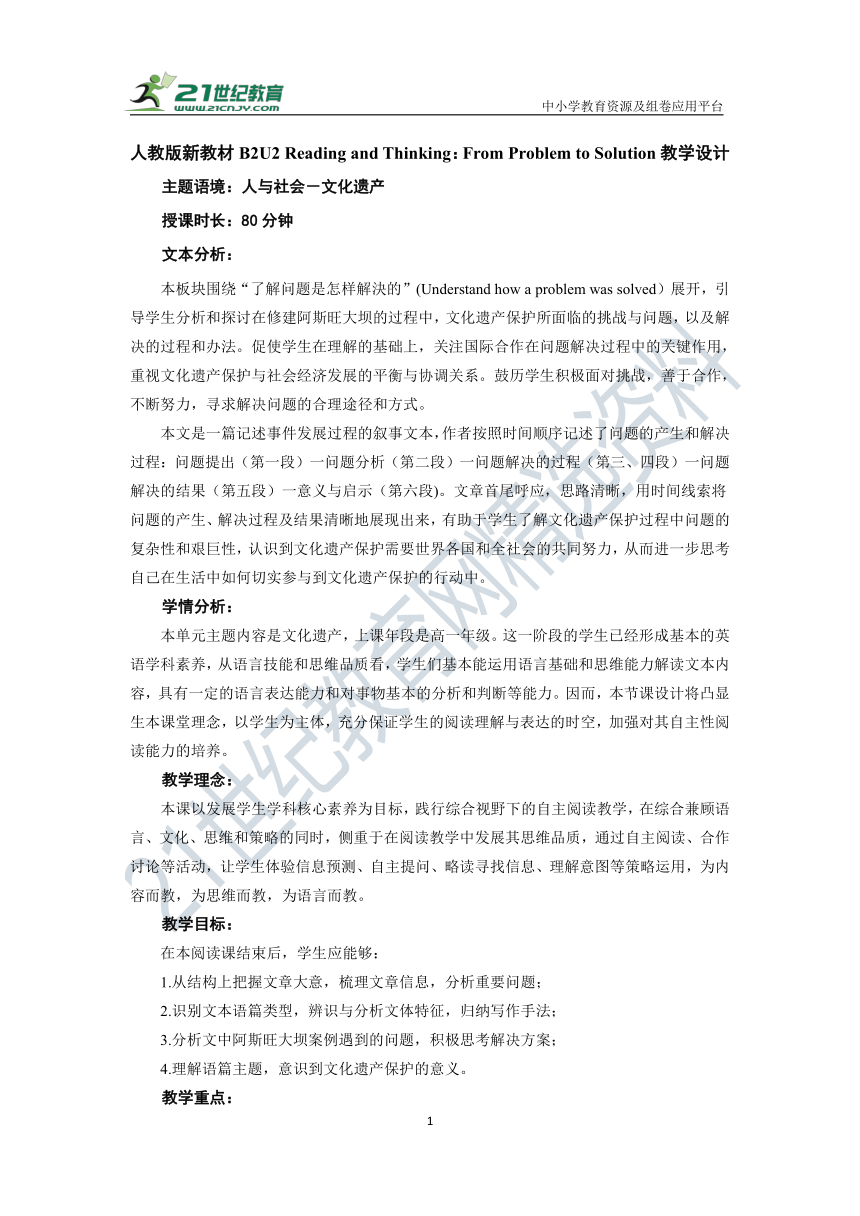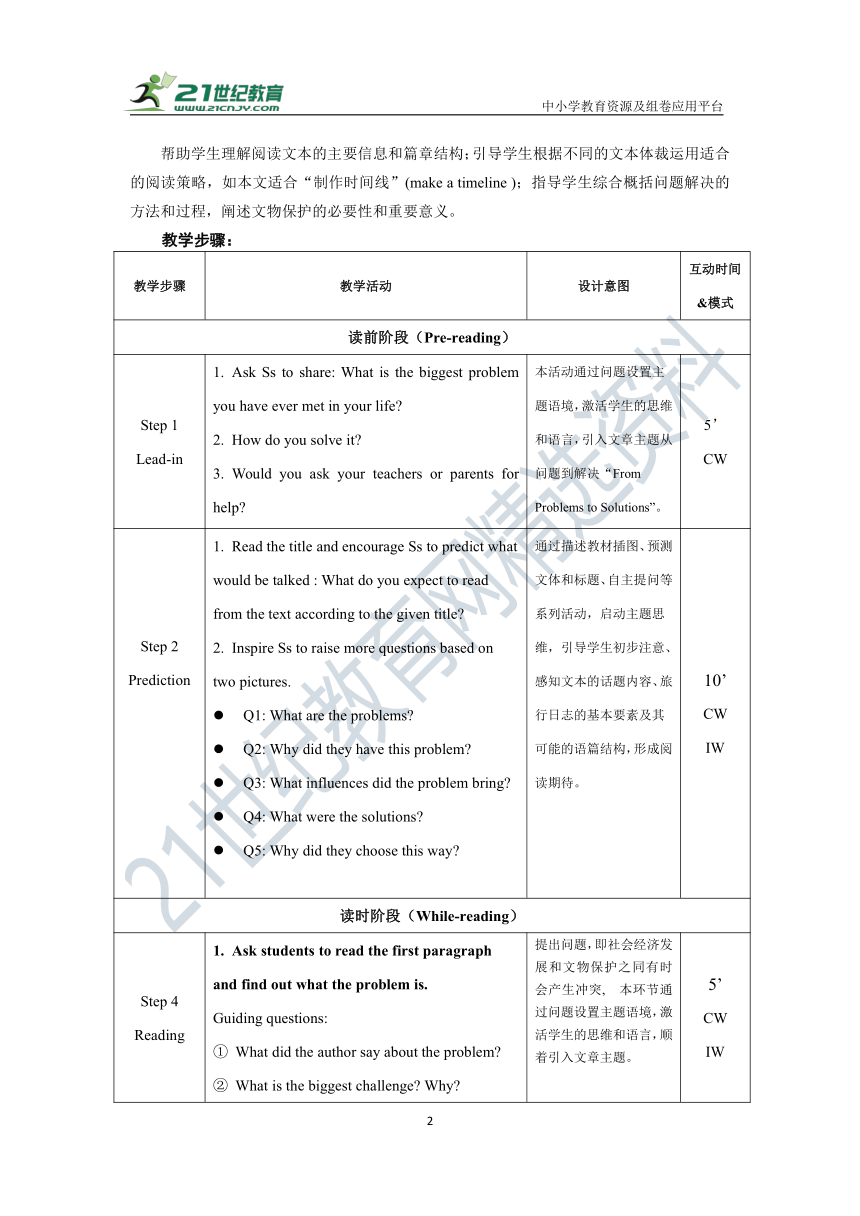人教版(2019)必修第二册 Unit 1 Cultural Heritage 读思课教学设计
文档属性
| 名称 | 人教版(2019)必修第二册 Unit 1 Cultural Heritage 读思课教学设计 |  | |
| 格式 | docx | ||
| 文件大小 | 231.0KB | ||
| 资源类型 | 试卷 | ||
| 版本资源 | 人教版(2019) | ||
| 科目 | 英语 | ||
| 更新时间 | 2024-09-20 20:04:02 | ||
图片预览


文档简介
中小学教育资源及组卷应用平台
人教版新教材B2U2 Reading and Thinking:From Problem to Solution教学设计
主题语境:人与社会-文化遗产
授课时长:80分钟
文本分析:
本板块围绕“了解问题是怎样解決的”(Understand how a problem was solved)展开,引导学生分析和探讨在修建阿斯旺大坝的过程中,文化遗产保护所面临的挑战与问题,以及解决的过程和办法。促使学生在理解的基础上,关注国际合作在问题解决过程中的关键作用,重视文化遗产保护与社会经济发展的平衡与协调关系。鼓历学生积极面对挑战,善于合作,不断努力,寻求解决问题的合理途径和方式。
本文是一篇记述事件发展过程的叙事文本,作者按照时间顺序记述了问题的产生和解决过程:问题提出(第一段)一问题分析(第二段)一问题解决的过程(第三、四段)一问题解决的结果(第五段)一意义与启示(第六段)。文章首尾呼应,思路清晰,用时间线索将问题的产生、解决过程及结果清晰地展现出来,有助于学生了解文化遗产保护过程中问题的复杂性和艰巨性,认识到文化遗产保护需要世界各国和全社会的共同努力,从而进一步思考自己在生活中如何切实参与到文化遗产保护的行动中。
学情分析:
本单元主题内容是文化遗产,上课年段是高一年级。这一阶段的学生已经形成基本的英语学科素养,从语言技能和思维品质看,学生们基本能运用语言基础和思维能力解读文本内容,具有一定的语言表达能力和对事物基本的分析和判断等能力。因而,本节课设计将凸显生本课堂理念,以学生为主体,充分保证学生的阅读理解与表达的时空,加强对其自主性阅读能力的培养。
教学理念:
本课以发展学生学科核心素养为目标,践行综合视野下的自主阅读教学,在综合兼顾语言、文化、思维和策略的同时,侧重于在阅读教学中发展其思维品质,通过自主阅读、合作讨论等活动,让学生体验信息预测、自主提问、略读寻找信息、理解意图等策略运用,为内容而教,为思维而教,为语言而教。
教学目标:
在本阅读课结束后,学生应能够:
1.从结构上把握文章大意,梳理文章信息,分析重要问题;
2.识别文本语篇类型,辨识与分析文体特征,归纳写作手法;
3.分析文中阿斯旺大坝案例遇到的问题,积极思考解决方案;
4.理解语篇主题,意识到文化遗产保护的意义。
教学重点:
帮助学生理解阅读文本的主要信息和篇章结构;引导学生根据不同的文本体裁运用适合的阅读策略,如本文适合“制作时间线”(make a timeline );指导学生综合概括问题解决的方法和过程,阐述文物保护的必要性和重要意义。
教学步骤:
教学步骤 教学活动 设计意图 互动时间&模式
读前阶段(Pre-reading)
Step 1 Lead-in Ask Ss to share: What is the biggest problem you have ever met in your life How do you solve it Would you ask your teachers or parents for help 本活动通过问题设置主题语境,激活学生的思维和语言,引入文章主题从问题到解决“From Problems to Solutions”。 5’ CW
Step 2 Prediction Read the title and encourage Ss to predict what would be talked : What do you expect to read from the text according to the given title Inspire Ss to raise more questions based on two pictures. Q1: What are the problems Q2: Why did they have this problem Q3: What influences did the problem bring Q4: What were the solutions Q5: Why did they choose this way 通过描述教材插图、预测文体和标题、自主提问等系列活动,启动主题思维,引导学生初步注意、感知文本的话题内容、旅行日志的基本要素及其可能的语篇结构,形成阅读期待。 10’ CW IW
读时阶段(While-reading)
Step 4 Reading Ask students to read the first paragraph and find out what the problem is. Guiding questions: ① What did the author say about the problem ② What is the biggest challenge Why 提出问题,即社会经济发展和文物保护之同有时会产生冲突, 本环节通过问题设置主题语境,激活学生的思维和语言,顺着引入文章主题。 5’ CW IW
Ask students to read the second paragraph and find out: Why did they have this problem Guiding questions: ① What is the result ② What happened later Students try to make a timeline telling the process of solving this problem. Guiding questions: ① Why did they listen to scientist and citizen first ② What happened later ③ When was the first temple moved ④ How about the over next 20 years ⑤ What does the word “rescue” mean ⑥ Were there any other participants ⑦ What the result of the project 4. Group work: Why was it a great success 问题的设置旨在训练学生寻读能力,让学生快速找到数宇,并了解数字的意义。训练学生查询、重组信息,然后进行概括的能力。 引导学生根据文本体裁运用阅读策略〝制作时间线" ( make a timeline );训练学生用时间线将重要事件串联起来的能力。培养学生的高阶概括思维能力。基于文本的高阶思维和观点表达训练。 指导学生综合概括问题解决的方法和过程,阐述文物保护的必要性和重要意义即联合国是如何应对这个问题的,加深对文本的理解。 15’ IW GW CW
读后阶段(Post-reading)
Step 5 Reading for Thinking What is the spirit of Aswan Dam project today Is the Aswan Dam project worthwhile Can we figure out a general solution when facing such kind of balance problem 依托深化理解类读后活动,通过再次解读标题,深度分析推断作者的写作意图。基于此,引导学生以一句话总结所学内容的方式,个性化表达主题意义和观点思想。 30’ IW PW CW
Step 6 Assignment Try to write a passage on an annoying problem in our campus. What you should do is to apply the steps of solving problems learned in our passage. 运用问题分析模式和所学general-specific文本模式,来分析这个问题,做到课本中学,生活中用,从书本知识迁移到实际生活的运用,从而提高学生的迁移应用能力。 10’ IW PW CW
备注:Ss: Students IW: Individual work GW: Group work CW: Class work
板书设计:
From Problems to Solutions
What are the problems What were the solutions
Why did they have this problem Why did they choose this way
What influences did the problem bring
2
人教版新教材B2U2 Reading and Thinking:From Problem to Solution教学设计
主题语境:人与社会-文化遗产
授课时长:80分钟
文本分析:
本板块围绕“了解问题是怎样解決的”(Understand how a problem was solved)展开,引导学生分析和探讨在修建阿斯旺大坝的过程中,文化遗产保护所面临的挑战与问题,以及解决的过程和办法。促使学生在理解的基础上,关注国际合作在问题解决过程中的关键作用,重视文化遗产保护与社会经济发展的平衡与协调关系。鼓历学生积极面对挑战,善于合作,不断努力,寻求解决问题的合理途径和方式。
本文是一篇记述事件发展过程的叙事文本,作者按照时间顺序记述了问题的产生和解决过程:问题提出(第一段)一问题分析(第二段)一问题解决的过程(第三、四段)一问题解决的结果(第五段)一意义与启示(第六段)。文章首尾呼应,思路清晰,用时间线索将问题的产生、解决过程及结果清晰地展现出来,有助于学生了解文化遗产保护过程中问题的复杂性和艰巨性,认识到文化遗产保护需要世界各国和全社会的共同努力,从而进一步思考自己在生活中如何切实参与到文化遗产保护的行动中。
学情分析:
本单元主题内容是文化遗产,上课年段是高一年级。这一阶段的学生已经形成基本的英语学科素养,从语言技能和思维品质看,学生们基本能运用语言基础和思维能力解读文本内容,具有一定的语言表达能力和对事物基本的分析和判断等能力。因而,本节课设计将凸显生本课堂理念,以学生为主体,充分保证学生的阅读理解与表达的时空,加强对其自主性阅读能力的培养。
教学理念:
本课以发展学生学科核心素养为目标,践行综合视野下的自主阅读教学,在综合兼顾语言、文化、思维和策略的同时,侧重于在阅读教学中发展其思维品质,通过自主阅读、合作讨论等活动,让学生体验信息预测、自主提问、略读寻找信息、理解意图等策略运用,为内容而教,为思维而教,为语言而教。
教学目标:
在本阅读课结束后,学生应能够:
1.从结构上把握文章大意,梳理文章信息,分析重要问题;
2.识别文本语篇类型,辨识与分析文体特征,归纳写作手法;
3.分析文中阿斯旺大坝案例遇到的问题,积极思考解决方案;
4.理解语篇主题,意识到文化遗产保护的意义。
教学重点:
帮助学生理解阅读文本的主要信息和篇章结构;引导学生根据不同的文本体裁运用适合的阅读策略,如本文适合“制作时间线”(make a timeline );指导学生综合概括问题解决的方法和过程,阐述文物保护的必要性和重要意义。
教学步骤:
教学步骤 教学活动 设计意图 互动时间&模式
读前阶段(Pre-reading)
Step 1 Lead-in Ask Ss to share: What is the biggest problem you have ever met in your life How do you solve it Would you ask your teachers or parents for help 本活动通过问题设置主题语境,激活学生的思维和语言,引入文章主题从问题到解决“From Problems to Solutions”。 5’ CW
Step 2 Prediction Read the title and encourage Ss to predict what would be talked : What do you expect to read from the text according to the given title Inspire Ss to raise more questions based on two pictures. Q1: What are the problems Q2: Why did they have this problem Q3: What influences did the problem bring Q4: What were the solutions Q5: Why did they choose this way 通过描述教材插图、预测文体和标题、自主提问等系列活动,启动主题思维,引导学生初步注意、感知文本的话题内容、旅行日志的基本要素及其可能的语篇结构,形成阅读期待。 10’ CW IW
读时阶段(While-reading)
Step 4 Reading Ask students to read the first paragraph and find out what the problem is. Guiding questions: ① What did the author say about the problem ② What is the biggest challenge Why 提出问题,即社会经济发展和文物保护之同有时会产生冲突, 本环节通过问题设置主题语境,激活学生的思维和语言,顺着引入文章主题。 5’ CW IW
Ask students to read the second paragraph and find out: Why did they have this problem Guiding questions: ① What is the result ② What happened later Students try to make a timeline telling the process of solving this problem. Guiding questions: ① Why did they listen to scientist and citizen first ② What happened later ③ When was the first temple moved ④ How about the over next 20 years ⑤ What does the word “rescue” mean ⑥ Were there any other participants ⑦ What the result of the project 4. Group work: Why was it a great success 问题的设置旨在训练学生寻读能力,让学生快速找到数宇,并了解数字的意义。训练学生查询、重组信息,然后进行概括的能力。 引导学生根据文本体裁运用阅读策略〝制作时间线" ( make a timeline );训练学生用时间线将重要事件串联起来的能力。培养学生的高阶概括思维能力。基于文本的高阶思维和观点表达训练。 指导学生综合概括问题解决的方法和过程,阐述文物保护的必要性和重要意义即联合国是如何应对这个问题的,加深对文本的理解。 15’ IW GW CW
读后阶段(Post-reading)
Step 5 Reading for Thinking What is the spirit of Aswan Dam project today Is the Aswan Dam project worthwhile Can we figure out a general solution when facing such kind of balance problem 依托深化理解类读后活动,通过再次解读标题,深度分析推断作者的写作意图。基于此,引导学生以一句话总结所学内容的方式,个性化表达主题意义和观点思想。 30’ IW PW CW
Step 6 Assignment Try to write a passage on an annoying problem in our campus. What you should do is to apply the steps of solving problems learned in our passage. 运用问题分析模式和所学general-specific文本模式,来分析这个问题,做到课本中学,生活中用,从书本知识迁移到实际生活的运用,从而提高学生的迁移应用能力。 10’ IW PW CW
备注:Ss: Students IW: Individual work GW: Group work CW: Class work
板书设计:
From Problems to Solutions
What are the problems What were the solutions
Why did they have this problem Why did they choose this way
What influences did the problem bring
2
